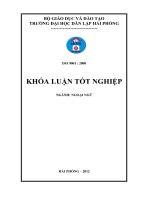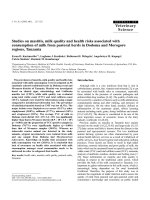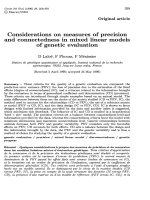STUDIES ON EARTHWORMS OF INDIANA AND ILLINOIS
Bạn đang xem bản rút gọn của tài liệu. Xem và tải ngay bản đầy đủ của tài liệu tại đây (3.8 MB, 80 trang )
THE UNIVERSITY
OF ILLINOIS
LIBRARY
bis
STUDIES ON
EARTHWORMS OF INDIANA
AND
ILLINOIS
BY
HARRY VIRL HEIMBURGER
A. B.
DePauw
University, 1911
THESIS
Submitted
in
Partial Fulfillment of the
Degree
Requirements
of
MASTER OF ARTS
IN
ZOOLOGY
IN
THE GRADUATE SCHOOL
OF THE
UNIVERSITY OF ILLINOIS
1915
for
the
UNIVERSITY OF ILLINOIS
THE GRADUATE SCHOOL
_
I
.June
3.
1915
HEREBY RECOMMEND THAT THE THESIS PREPARED UNDER MY SUPER-
VISION BY
Harry.....Virl....Heimbu
ENTITLED
S.t.u.die.a.....Qii_..£a.r.t.jaiff.Q.rmja
_
DX....Indiaiia....aiid.....IH.i.nQ.i.a
BE ACCEPTED AS FULFILLING THIS PART OF THE REQUIREMENTS FOR THE
DEGREE OF
Mas.ter„..of ...Arts.
/^^^..m:::U-/X-.
':^ltLLJd3^.^
In Charge of Thesis
^"/^
Recommendation concurred
-^^a
in :*
Committee
on
Final Examination*
^Required for doctor's degree but not for master's.
Digitized by the Internet Archive
in
2013
/>
)
TABLE
I.
OF
CONTENTS
Introduction.
Scope of Work and Source of Material
Methods and Technique
Systematic and Geographic Relations
II*
Indiana Species
Key for Identification of Species
Notes on Indiana Species
SEac^aaofiiiiliii §i5sai ^* smith
lisiS^iilil 1^Stl!a§^3:us
fas^il'is (Sav.)
H, xassiis
IV.
V.
(Sav
(Sav.
li»
filllacotiSiS
(Sav.)
M*
Sali^inosus
(Sav.)
H.
laaiiiS
(Ude)
S«
tsaiis
(Eisen)
li»
^ieseleri,
I*
zetel^i Smith and Git tins
ll§a£eli
Qs^l§sium lacteum
III.
t^EliSJis
(Ant. Dug.)
F.
Smith
(Oerley)
Description of New Forms
Literature Cited
Explanation of Plates
3181S3
UlUC
1
STUDIES ON EARTHWORMS OP INDIANA AND ILLINOIS.
INTRODUCTION
Scope of Work and Source of Material.
This paper is an account of a systematic and faunistic
study of earthworms of Indiana toj^ather with descriptions of a new
variety and two new species of which one vvas found in Illinois,
During the summer of 1914 the writer made collections of earthworms in
It was intended that a more complete collecsix counties of Indiana,
tion should have been made but owing to the extreme drought of the summer
it was practically impossible to do any collecting during July and
August,
The collections contain a number of species not previously
reported for the state of which some are new to science.
Very little
has been done with this group of animals within the state and the
literature of the group contains very few references to Indiana.
In
April 1914 the writer collected some earthworms near White Heath, Piatt
Illinois among which is a specimen that forms the basis for
the description of a new species from Illinois.
county,
This work was done under the direction of Professor
Prank Smith whose private library has made available a number of
publications that have been of material assistance in these studies.
Methods and Technique.
All
identifications were made from
and preserved material and from serial sections.
a
study of
living
In most cases it
was possible to compare this material with specimens from the collection
of Professor Smith and in some cases either types or paratypes of the
Sagittal sections from the anterior part of
In making these sections
the worms are most useful in these studies.
about twenty anterior somites are split in the median sagittal plane
species were available.
and one half removed for sectioning the remaining part of the worm
The sections were stained
being preserved as an alcoholic specimen.
with haematoxylin and eosin.
The material was fixed as soon after collecting as
possible, no attempt being made to clear the worms of earthy matter
2
in the alimentary tract.
The worms were anaesthetized by the
A few worms are placed in a little water
chloroform method as follows,
A drop or two of chloroform is placed on a
in a Mason *s fruit jar.
pad of blotting paper which is fitted into the cover of the jar.
The
cover is placed securely on the jar and the worms left for about half an
hour when a few more drops of chloroform may be added and the worms
When the specimens do not respond to
left until fully anaesthetizied.
strong stimulation they are placed one at a time in the fixing agent
Care must be taken not to add too
and kept straightened until dead.
If more than two or three drops are used in
much chloroform at first.
the beginning of the process the worms will be much irritated and may
die in so contorted and contracted a condition as to be useless for
If only a little chloroform is used until the worms are
sections.
partly anaesthetized this method gives as good results as ohlorotone
and requires less attention.
The fixing agent that was found most satisfactory for
use in the field is a mixture of alcohol and formalin to make a four
This solutcent solution of formalin in fifty percent alcohol.
per
ion requires no troublesome after treatment as the specimens may be
left in the solution indefinitely or may be transferred later to
eighty-five percent alcohol, which is the most desirable strength of
The alcohol-formalin
alcohol for the preservation of such material.
mixture has an added advantage in that specimens which are left in it
Specimens
retain much of their natural color for several months.
if
kept in this solution stain well with haematoxylin and eosin, but
some
material is desired for finer histological and cytological work,
these agents
of the corrosive sublimate preparations are better though
are rather troublesome to handle in the field.
Systematic and Geographic Relations.
The term Earthworms as used in this paper includes
Moniligastridae,
those 01 igochaeta which belong to the four families;
But three of these
Megascolecidae, Glossoscolecidae and Lumbricidae.
being
families are represented in our fauna, the Moniligastridae
islands.
limited to Borneo, Ceylon, Southern India and adjacent
The Megascolecidae is the largest family of the group
(Smith, '12H4-i>)
and probably originated during the early mesozoic.
tropical regions
This family is very widely distributed, chiefly in
The genus DiElaSficOia is represented
and in the southern hemisphere.
Lower California. Texas,
in our fauna and is known from Mexico,
Florida,
Nebraska,
North Carolina and Illinois.
This ^enus was first
established by Garman (Garman, '38:47 ) for material obtained at
Urb ana, Illinois.
My collections contain a number of specimens of
Diplocardia from Indiana, most of which were collected late in the
summer in Putnam and Vigo counties.
As but few of these specimens are
sexually mature the species cannot be determined with any degree of
certainty.
It seems evident, however, that there are new forms among
them.
A study of the Diplocardia species will be undertaken at a
later time when it is hoped that more and better material may be at hand
The family Glossoscoleoidae appears to have developed
in the northern continental region as early as the Jurassic.
One
is found in Uexico and various
genus of this family,
parts of the United States.
The fanily Lumbricidae is recognized as the most
recent of the group and is derived from the Glossoscoleoidae, probably
in Southwestern Asia. (Michaelsen, '10:2
The family is thought
)
to have invaded Europe in the Eocene and North America in the Oligocene.
Most of the species found in America are Suropean species of which
many have been introduced in recent times through the agency of man.
Several endemic species are known from the United States and undoubtedly
others will be discovered by more extensive collecting.
Michaelsen
('10:2-10,) recognizes three genera in this family all of which probably are represented in Indiana,
genus
liillkciSiiS
si^*®
though no representatives of the
y®t known from the state.
INDIANA
SPECIES
In the discussion of each of the Indiana species
identified there is given a brief description or definition together
with notes on the character of the locality and habitat in which the
specimens were collected and a brief statement of the known range
In all cases where Indiana is not mentioned in this
of the species.
statement of the range of species,
it
is believed that this is the first
Data concerning the
report of the occurrence within the state.
geographical range of species were obtained chiefly from papers by
Michaelsen.
(See particularly, Michaelsen,
'03.)
The following key for the identification of species
includes several which have not been found in the state but which are
known to occur in the eastern half of the United States and may be
expected in Indiana. This key has been made from published descriptions and from a study of actual specimens of upwards of twenty of the
4
included species. Of some species no specimens were available but in
The key is
such oases the original descriptions have been consulted.
based chiefly upon external characters, but in many cases satisfactory
identifications cannot be made without a careful study of sections.
In the key and in other parts of the paper the roman
Symbols like V/VI indicate
numerals are used to designate somites.
either septa or intersegmental grooves as shown by the context. The
small letters ^, ii, fi, and ^ indicate setae, ab being the ventral
Ifhen some structure is said to
pairs and ad being the lateral pairs.
etc, it is meant that the structure is in
occur in line ^ or line
the longitudinal lines which would connect all of the setae ^ of either
side or is between the parallel lines connecting all of the setae 2
Other terms used are those in general use in the
and the setae ^«
literature of the group and are for the most part self explanatory.
Following each of the definitions of species is a bracketed citation to
literature in which a more extended account of the species may be found.
KEY FOR THE IDSNTIPICATION OF SPECIES1.
Clitellum beginning anterior to XVI
2
Clitellum beginning posterior to XVI,
Family,
2.
Clitellum on XIII— XVIII.
Family,
Family,
MEGASCOLECIDAE
DIPLOCARDIINAE
GLOSSOSCOLECIDAE
Pubertatic region on XVII
CRIODRILIINAE
— XX.
Pubertatic region on 1/4 XVIII
on XX.
4.
5»
6.
3
Prostomium zygolobic.
Sub Fam.
3»
12
Prostomium epilobic.
Sub Fam.
Clitellum on XV— XXV.
—
LUMBRIGIDAE
Spermiducal pores on XIX
— 1/2
XXII.
—
11
4
Spermiducal pores
fiialaaaciia varciiaas^ (ude)
Two pairs of speps-sacs
—
Prostomium epilobic.
Prostomium tanylobic. Three pairs of sperm sacs.
5
^i^Ig^SCdis lifill^lssni Si sen.
Spermathecae, three pairs
6
Spermathecae, two pairs ( very rarely three pairs in I2« siSfiUi)- 9
•
- 7
Dorsal vessel single
Dorsal vessel double, except a few anterior somites.
Sacculated intestine begins in XVII.
Dipl ooardia fifiaiuais G arm an.
——— —
—
7.
Sacculated intestine begins in XVII,
Gizzards in V and VI.
Spermathecal setae not modified*
Size,
less than
100 mm. long
8
Sacculated intestine begins in
Gizzards in VI and VII.
XVIII.
Spermathecal setae modified. Larger, 275
long.
m
DifilafiaCJiia
8.
lail^ J» P« Moore.
Paired pubertatic papillae on
Penial setae not ornamented.
XVII and XX, sometimes also on XXI and XXII.
(Ode).
£i&ISl£a£iila
m^IasU
Pubertatie papillae paired on
XVII and XXI; median unpaired on XXII.
Penial setae ornamented.
Di^I^^^iU sac^iiniana
9»
Spermathecal pores anterior
Spermathecal setae not modified.
Sacculated intestine begins in
on VIII and IX in line ak.
Last heart in XIII.
XVIII.
Dorsal vessel single.
220—250
mm.
long.
Smith.
—— — —
DiEifisarlLa ciaaria
—
spermathecal setae nodified
10.
Eisen.
~
10
Spermathecal pores anterior on
Penial setae ornamented.
VIII and IX in line b. Three pairs of elongated papillae
— XXI.
Sacculated intestine begins in XVII.
Dorsal vessel single.
70 90 mm. long.
on XVIII
—
^ElaSSil^ia
iiisi
Si sen.
Penial setae not well developed, not ornamented.
Spermathecal
pores posterior to a in line ak» usually two pairs on
VIII and IX, occasionally three pairs on VII— IX.
Pubertatic region on XVIII
— XX,
intestine begins in XVIII.
of somites
VI— XV.
30— 160
Dorsal vessel double in part
mm.
Prostate-like glands
Large coelomic glands opening
Spermiducal pores on XIX, inconspicuous.
in
XXII— XXV or
XXVI,
anterior to §b in
HI
and IV,
Saa£^ajifl£iiiiiiis
12.
Prostomium
aissai
epilobic
Prostomium tanylobic
13»
smith.
™— —— — — — —
——
F".
— ——————
Clitellum beginning anterior to XXX
Clitellum on XXX— XXXV.
QstaUsiM laaiSM
14.
long.
(Mchlsn).
Si&l2<2a£^ia
11.
without papillae. Sacculated
13
31
14
(Oerley).
Clitellum beginning anterior to XXIV
Clitellum beginning on XXIV or posterior to XXIV
-—
—
—
15
19
15«
Clitellum on XX
'
lacking.
— 1/2
XXX, Tuberoula pubertatis and spermatheoae
Sperm sacs in XI and XII.
(Ude).
HsI^iiialUS ^ISSSlacl
Clitellum beginning posterior to XX
16.
l6
Tubercula pubertatis and spermaClitellam on XXIII— XXXII.
Sperm sacs in XI and XII.
theoae lacking.
iisLadcilas laa^ifiiaQiaa smith and Gittins.
Clitellum beginning on XXII or XXIII. Tuberoula pubertatis
and spermatheoae present
17.
——
—
is
Tubercula pubertatis on XXIII or 1/2 XXIII— XXV or XXVI.
Spermiducal pores on XIII, prominent.
Tubercula pubertatis as above.
Spermiducal pores on XV.
Clitellum on XXII— XXIX or 1/2 XXX.
(Uchlsn)
hscaxiim
Msl^dniliilS IfilCSSiixiUS
18.
17
Tubercula pubertatis
Clitellum beginning on XXII or XXIII.
and spermatheoae lacking
—
•
Spermiducal pores on XV,
not especially proninent.
Esladcilas ^iaafilsci hsta§U. p. Smith.
Spermiducal pores on XV, very
Clitellum on XXIII— XXVIII.
large glandular prominence.
IsladcUaa ELalnaicU
19.
XXVIII,
Moore.
or XXIX
Clitellum on XXIV— XXX.
20
——.
Spermatheoal pores near dorsal median line
Spermathecal pores lacking or, if present,
21.
f.
Clitellum beginning on XXIV, XXV, or XXVI
Clitellum beginning on XXVII,
20.
h.
25
•
ventral to
^
—
21
24
Tubercula pubertatis on XXVI— 1/2 XXIX.
Three pairs of spermatheoae.
Setae a and |i of somites
XXIV— XXX in papillae, modified into sexual setae.
Ssl2
Clitellum on XXIV— XXXI.
(Mchlsn).
Tubercula pubertatis on XXVII— XXIX.
Two pairs of spermatheoae.
Clitellum on XXIV, XXV, or XXVI— XXXII or
22.
XXXIII———
Spermatheoae in X and XI.
H§l2dcllaa
Spermatheoae in IX and
^caliaaasU
J«iohisn.
X.
HsI^ciliia ^sc&U&saala
^k^^clsuliia
n.
var.
22
23
)
)
)
7
23.
Tuberoula pubertatis on XXVIII or 1/2 XXVIII— XXX or XXXI.
Color; red, purple or brown with yellow rings at intersegmental grooves,
MsUsiclUs laaUdiis
(Sav.
—
Color; flesh, no
Tuberoula pubertatis on XXIX or XXX XXXI.
yellow rings, clitellum usually orange.
24.
Hfilfi^CUaS ESiSaSlS (Sav. )
Clitellum on XXV,
Spermathecae present.
XXVI— XXXX or
XXXII.
Tuberoula pubertatis on XXVIII— XXX. Two pairs of spermathecae.
Helo^SlIlia fiUbiakisflndiiS (Eisen)
———
25.
26.
—™
Spermathecae lacking
27
26
Clitellum on XXVII or XXVIII— XXXIV or XXXV
Tuberoula pubertatis three
Clitellum on XXVIII or XXIX— XXXVII.
pairs of small sucker-like papillae on XXXI, XXXIII,
and XXXV.
Three pairs of spermathecae in IX, X, XI.
—
.
——
Heiaisiliis slilaEfiUaas (Sav.
Tuberoula pubertatis on XXXI and XXXIII. 60 to l60 mm. long.
S§i olnilsis saiUiaasus, iiEisus ( Sav.
Tuberoula pubertatis on XXXI XXXIII. 60 to l60 mm. long.
—
HsladcUas salUiaasas JtcaEiaaaUas (Ant. Dug.)
Tuberoula pubertatis on XXXI— XXXIV or 1/2 XXXV. 110 to 270 mm.
HslaicUiia laagjia (ode)
Tuberoula pubertatis present but indistinct
Tuberoula pubertatis lacking ( sometimes present, indistinct,
long.
27»
in
28.
laaais. )
Clitellum on XXIV XXX. Tuberoula pubertatis,
—
25 to 40 mm.
Saladcilas uacsas (Eisen)
Clitellum on XXIV or XXV— XXXI or 1/2 XXXII.
tatis,
30.
29
fl.
XXV or XXVI— XXIX or XXX.
29.
28
indistinct, on XXV or
XXVI— XXX.
indistinct, on
long.
Tuberoula puberl7 to 46 mm.
long.
(Mchisn)
IsLaicilJis aadlasdi
Clitellum on XXV— XXXIII
30
31
Clitellum not as above
Spermiducal pores with slight glandular prominences.
Color, red.
Modified setae on XV and XVI.
Ssladcllus aaliacsasU n. sp.
Spermiducal pores with very large
Pale, scarcely pigmented.
glandular prominence and with large atrial chamber.
No modified setae.
iela^ilas aaassi
n.
sp.
8
3U
Clitsllum on XXVI
— XXXI,
Sometimes with tubercula pubertatis
very indistinct on XXVIII and XXIX; usually no trace of
20 to 50 mm, long.
tubercula pubertatis.
Hsiadciias tsaiiifi (Eisen)
Clitellum on XXVII— XXXVII or XXXVIII. Tubercula pubertatis
lacking.
70 to 140 mm.
long.
Smith and Gittins.
Tubercula pubertatis on
IsIfiicililS ZS.tt§^L
32.
Clitellum on XXVI or XXVII— XXXII.
XXVIII— XXXI.
Liil^liSiiS
Ho f fro.
CUbailus
Clitellum on XXXI or XXXII— XXXVII,
Tubercula pubertatis on
XXXIII or 1/2 XXXIII— 1/2 XXXVI or XXXVI.
Lumbcisus ISHISS^ls
Linn.
Mflll.
Notes on Indiana Species.
S2^rai22£Mlas Sissai
Color, bluish or smoky gray.
180 ««. to 200 mm.
dorsally;
1/2 XXII.
cd .
Diameter,
Frank Smith.
Prostomium zygolobic.
2.6 mm.
Clitellum on 1/4
Length,
XV— XXV
XIV— XXVI ventrally.
Tubercula pubertatis on 1/2 XVII—
Spermathecal pores, three pairs, VI/VII— VIII/IX in line
1/2
Spermiducal pores on XIX close above the tubercula pubertatis.
^2 is less than
§a is less than bs;
equals 1,1/2
anteriorly;
equals 1,1/4 33 about middle of
length.
Sperm sacs, two pairs in XI and XII.
Three or four pairs of
Setae closely paired:
^
prostate-like glands in XXIII
— XXV
or XXVI,
opening near setae
b.
Large coelomic glands open in front of ab in III and IV.
(Smith, '95:142.)
This species is aquatic in habit, being found in mud of the
Collected in large numbers in mud
borders of streams, ponds and lakes.
at the edge of a small stream near Xewanna, Fulton Co. and in mud and
vegetable drift along the margin of Lake Maxinkuckee in Marshall Co.
A few immature worms were taken later in the season on the roots of
aquatic plants at Lake Maxinkuckee,
in depth.
in water of about eighteen inches
While the determination of these latter specimens is not
certain, they appear to be S« sissai*
T^is species is known from Illinois, Michigan and Florida and









